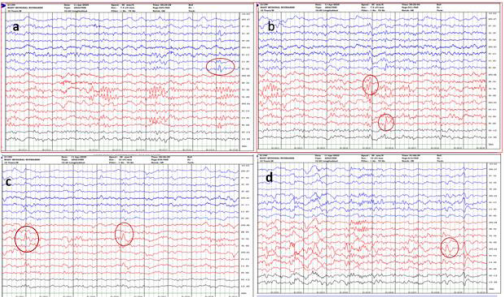Prolonged Febrile Illness and Gastrointestinal Symptoms in Panayiotopoulos Syndrome: An Autonomic Status Epilepticus
- 1. Department of Pediatrics, Radiant Children Hospital, Jodhpur, India
KEYWORDS
• Autonomic Status Epilepticus
• Prolonged Fever
• Gastrointestinal Symptoms
• Valproate
• SeLAS
CITATION
Joon P, Prolonged Febrile Illness and Gastrointestinal Symptoms in Panayiotopoulos Syndrome: An Autonomic Status Epilepticus. JSM Pediatr Neurol 5(1): 1019.
CASE PRESENTATION
A 10-year-old male child presented with a 20-day history of recurrent fever, vomiting, epigastric pain, frequent small amount loose stool, headache, and nausea. Prior to this admission, he had been evaluated at multiple hospitals where he received intravenous antibiotics for fever. Initial investigations done outside, including a complete blood count, ultrasound of the whole abdomen, and contrast-enhanced CT (CECT) of the head, were all unremarkable. On admission, the child was conscious with an intact Glasgow Coma Scale (GCS) but showed signs of some dehydration. Neurological examination was normal. Given the episodic nature of his symptoms, a provisional diagnosis of self-limited epilepsy with autonomic seizures (SeLAS, formerly Panayiotopoulos syndrome) with possible autoimmune involvement, along with migraine, was considered. He was managed with intravenous rehydration and a loading dose of IV valproate, which resulted in significant symptomatic improvement within six hours. A subsequent sleep EEG revealed multifocal sharp waves, predominantly in the left temporal region (T6), with occasional sharp discharges in the bilateral occipital (O1, O2) and right frontal (F4) regions, consistent with SeLAS (Figure 1).
Figure 1 Sleep EEG revealed 1Hz multifocal sharps seen in O1 (a), in T6 and O2(b), in T6 (c), in F4 lead(d)
Further history -taking revealed that the child had experienced similar intermittent episodes in the past characterized by vomiting and headache, sometimes progressing to loss of consciousness, suggesting a longstanding history of autonomic seizures for last three years. Autonomic signs and symptoms during autonomic seizures and autonomic status has been described by Ferrie C et al. [1], which corroborate in our case . Autonomic seizures typically reflect focal-onset epilepsy. When prophylaxis is needed, both focal-specific agents (e.g., carbamazepine) and broad-spectrum AEDs (e.g., valproate) are effective options, with choice depending on individual patient factors and seizure characteristics [1]. In our case child was previously not on any medication, a trial of valproate in controlling autonomic status was successful. Panayiotopoulos syndrome is frequently missed because its hallmark symptoms - prolonged vomiting and autonomic dysfunction - are commonly attributed to everyday childhood illnesses like stomach bugs or migraines. Even doctors often overlook that these are actually seizure manifestations. Mild cases get mistaken for temporary conditions like motion sickness or fainting spells, while severe episodes can look like dangerous neurological emergencies such as encephalitis or poisoning, leading to unnecessary tests and delays in proper treatment [2-4]. This case report emphasis the timely identification of autonomic status and emphasis on the timely identification of prolonged duration of symptoms being misdiagnosed and delaying treatment.









































































































































